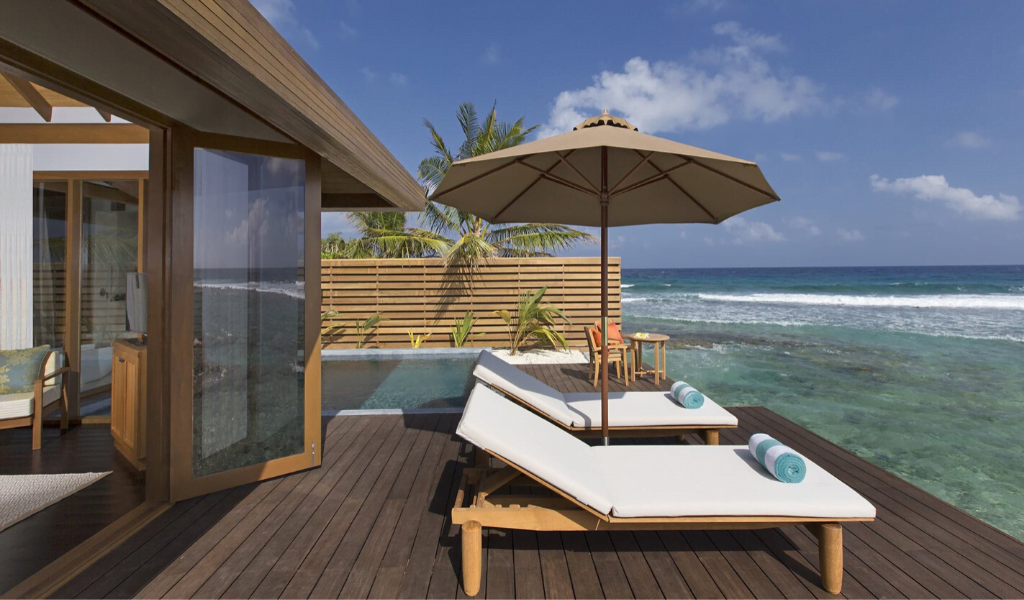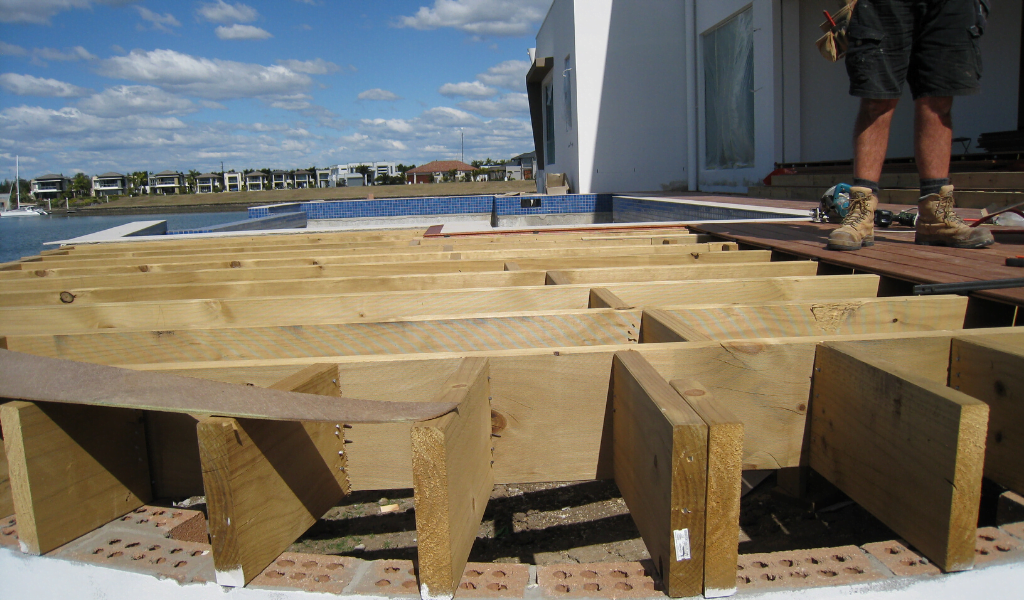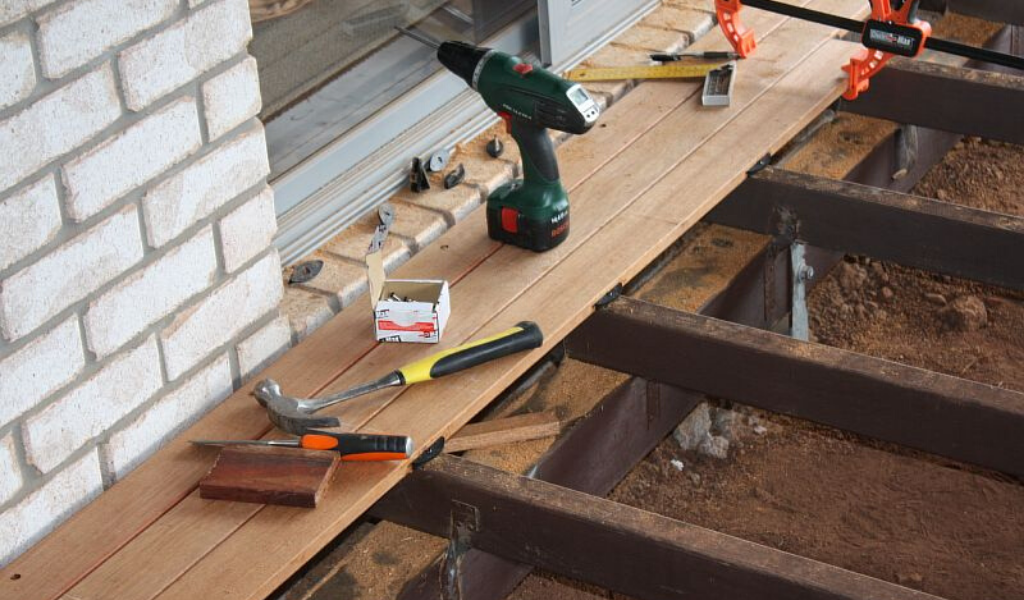In an effort to continue our education in regards to timber decking, we have written this article as a reference for timber deck fixings. This should help you understand what goes into building their own timber decking as we explain the different components of a timber deck. At the same time, we touch on the reasoning behind some of the things you must keep in mind when building a timber deck. As always, we open ourselves to you for your questions or comments. Read on below for more information and do not forget to drop us a line with your thoughts and questions.
Timber Deck Fixings

Most timber decks are going to be outdoor structures. As such, it is imperative that you choose the appropriate type of timber for your decking projects. They need to be able to withstand the harsh rigours of the elements over time. This goes for the timber decking as well as the supporting timber. Timbers that will be in the ground or have contact with the ground should have a natural durability rating of one or two in-ground contact. They might also have a preservative treatment rated at H4. For timber decking that will be above ground, it is strongly recommended to have an outside above ground natural durability of 1 or 2. Similarly, these above ground timber decking materials may have a preservative treating of H3. Suitable hardwoods for outdoor timber decking in Australia include Blackbutt, Blue gum, Ironbark, Merbau, River red gum, Spotted gum, Tallowwood, Turpentine, Treated pine and Cypress.
Timber Posts
Rather than placing timber posts directly within the foundation, it is recommended to use support post stirrups. These galvanized accessories will keep the posts off the ground, which serves a few purposes. First, it limits the time the posts spend sitting in water. Concrete is designed to retain some moisture. For a support post within that concrete, it means faster rot. At the same time, by keeping the timber decking support posts off the ground, it is limiting the chance of termite infestation. This also helps to protect the rest of your home by not serving as a bridge for the termites to get into your house. This is a concern even with treated timber. In any event, a termite barrier should be used around the posts for your timber decking.
Timber Decking Profiles
Another consideration you will need to make when building your timber deck is the timber decking profile. There are three options. The first is the plain profile. This is a squared surface on all edges, with right angles at each corner. The next option is the pencil round profile. This is similar to the plain timber decking profile, except each of the corners has been slightly rounded. Alternatively, a reeded profile for your timber decking has one flat, wide side with rounded edges like the pencil round profile. The other wide side of the reeded profile is ridged. There are several rumours regarding whether it matters which side of the reeded profile timber decking is facing up or down, but these are just rumours. It does not matter whether the ridged side is up or down when it comes to the structural stability or longevity of your timber decking. Instead, as with the other forms of timber decking profiles, it makes only a cosmetic difference.
Timber Decking Spacing

When laying your timber decking, it is also important to space out each of the boards from one another. Throughout the seasons, timber decking boards will soak up and expel moisture. This is true whether the timber is treated or not. Even when sealed or coated, the spacing between timber decking must be sufficient enough to allow for the expansion that the boards will undergo repetitively through the seasons.
The exact spacing needed for timber decking boards depends on the specific timber you will be using. Your timber decking supplier should provide you with the manufacturer’s specifications regarding board spacing based on the type of timber used for your deck. Otherwise, the spacing needed is based on the type of timber, the size of the timber, and whether it is treated or untreated.
For timber decking boards less than 100 millimetres in width, the following provides a brief summary of recommended spacing:
- Softwood & Seasoned should have 4 to 5mm.
- Softwood & Unseasoned should have 3 to 4mm.
- Hardwood & Seasoned should have 3 to 4mm.
- Hardwood & Unseasoned should have 3 to 4mm.
Timber Decking & Joists Fixings
For an outdoor timber deck, it is common practice to use hot-dipped, galvanized nails, screws, and bolts. You may also opt for stainless steel or a similar variety. Two nails in a decking board to fasten to a joist should be staggered, not creating a single line. This will reduce the chance of a single line of nails creating the chance for split timber decking over time. The nails or screws should also not be driven straight down into the joist. Instead, they should be driven at opposite angles, toward one another, so as to increase the holding capacity of the nails, screws, or other fasteners.
There are nails and screws that have been designed in such a way so as to have their heads stick out above the top of the decking board. This is the design, and they are made to enhance the attractiveness of the timber decking. Others are designed so as to be driven down below the surface of the timber decking. If you use a nail or screw that is driven down below the surface of the board, this will create a void. That void should be filled with the appropriate filler. This will limit the moisture that collects in that area as well as the subsequent staining of the boards over time.
Be sure not to place the nails too close to the end of the board. By keeping the nails away from the edge, you will limit the chance of the boards splitting during construction and over time. It is also recommended to pre-drill the holes for the nails when attaching the end of the timber decking board to the joist. Depending on your deck design, you may have butt joists. If you do, be sure to avoid placing these butt joists next to one another under adjacent timber decking boards. Placement of the butt joists should be more random to prevent from weakening the structure of the deck.
You essentially have the choice to help protect the top of your timber decking joists. The first is to lay on a liquid coating to help seal and protect the joists—a lot like a pre-stain. The other option is to affix a protective strip to the top edge of the decking joists, which will help protect. These are specially designed, and you most likely would need to ask your local supplier for them rather than pick them up off the shelf. In any event, you will apply the protective method you have selected before you place and fasten the timber decking boards to the joists.
The AS 1684 Residential Timber Frame Construction Standard provides the minimum requirements for the spacing, size and grade of bearers and joists and the minimum requirements for the thickness, span, grade and fastenings for decking boards.
Attaching Timber Decking Boards to Steel Joists
Many will try to attach their timber decking board to steel joists. This method is seldom successful. The problem is, the screws have not been designed to last in fastening timber to steel. During periods of high humidity, the timber decking boards will expand. When the boards expand, the design of the screws does not allow them to compress. Instead, the screws will sheer and fail. Instead, if you need to use steel joists on a timber deck, you will want to affix a timber batten just above or beside the steel joist. You can then fasten the timber decking boards to the batten.
Finishing the Timber Decking
It is standard practice to apply at least a single coating of sealant to all sides of the timber decking board, especially any freshly cut edge. This is most often done before placing the decking boards on the joists and fastening them in place. The protective coating you apply should pierce the surface of the timber as well as leave a film on the outside of the timber. This protective coating will help to protect any timber from weathering. This goes for both treated and untreated timbers. This coating will limit the amount of moisture absorbed and expelled by the timber decking. Additionally, this coating should also contain a fungicide to prevent mould from growing on any of the sugars or starches used in the composition of the coating.
Timber Decking Tannin Bleed
Most timber decking will contain a water-soluble extract that helps to colour the timber. The extractive also helps to prevent the timber decking from decaying. When moisture exits the timber decking, there is a chance for this compound to be drawn to the surface and out of the timber, which will cause discolouration. As the compound is water-soluble, it can run off onto other surfaces. This is known as tannin bleed and can be quite difficult to remove from brick and concrete. The chances of this happening can be lessened by applying a quality protective coating to all timber decking surfaces.
Timber Decking Resin Bleed
Some softwood species of timber—particularly some forms of pine—may be prone to resin bleed. If you can detect this before building your timber decking, avoid using those boards as part of your deck. If you must use those boards as part of the timber deck, put them in an area where the resin bleed will not be so much of an issue. It is possible that the resin bleed issue with a board will go undetected until the timber deck is fully built. If that is the case, the resin can be cleaned up easily enough or the board can be replaced. If it was not detected at first, the resin bleed will generally appear after the timber decking has been exposed to hot weather.
Bushfire Resistant Timber Decking
AS 3959 – 1999 Construction in Bushfire Prone Areas, permits fire-retardant-treated-timber to be used in certain bushfire prone areas where the use of timber externally is otherwise not permitted. Included in the definition of fire-retardant-treated-timber are timber species which meet specified parameters without having to be subjected to a fire-retardant treatment. A number of species have been tested.
Seven Hardwood species have been shown to meet the parameters. They are: Blackbutt, Spotted gum, Red ironbark, Turpentine, River red gum, Silvertop ash and Merbau
